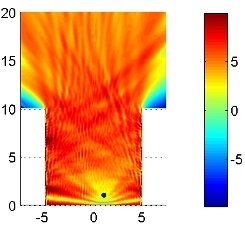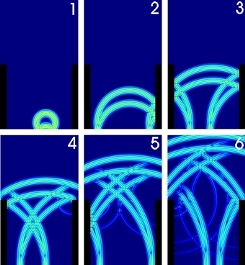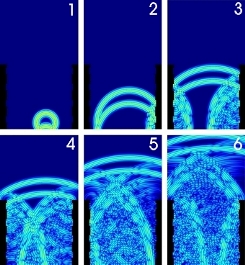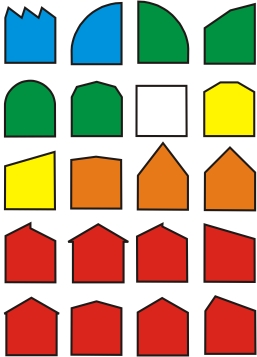Quiet sides
Noise annoyance surveys revealed that easy access to a quiet place in a noisy area reduces the percentage highly annoyed and sleep disturbed residents (Int. J. Env. Res. Publ. Health, 9, 4292-4310, 2012). The preservation of silent places in a city (like backyards) can therefore help to reduce the city noise problem.
Parameter study of sound propagation between city canyons
The centers of large urban areas consist of a number of confined spaces, enclosed by tall buildings. These are often called ‘‘city canyons’’. A good understanding of sound propagation near such city canyons is therefore important. The FDTD method was used to investigate sound propagation between adjacent city canyons (Appl. Ac. 67, 487-510, 2006).
The width-height ratio of the canyons seemed to be of limited importance in typical configurations. Very small canyons on the other hand resulted in significantly higher shielding. Downwind sound propagation significantly increases sound pressure levels in receiving canyons, especially in case of uniform building heights (J. Acoust. Soc. Am. 127, 3335-3346, 2010). Therefore, this aspect should not be neglected, as is usually done in sound propagation models, and leads to too optimistic evaluation of quietness in an urban area. Similarly, turbulent scattering into such acoustic shadow zones in a city was experimentally shown to be essential ("Improving the accuracy of engineering models at shielded building facades : experimental analysis of turbulence scattering", T. Van Renterghem et al., Proc. of Internoise 2013, Innsbruck, Austria.).
The importance of diffuse reflection
Facades of real buildings are not flat, and consist of smooth planes broken up by protrusions and recesses due to features such as windows, doors and architectural details. Diffuse reflection in urban situations is important because of the large number of reflections between the facades in a street canyon. Numerical calculations show a decrease in sound pressure level at the non-exposed canyon of 10 dB relative to a fully flat facade.
The main reason for this positive effect of a non-flat facade is a change in radiation pattern of the source canyon. With each reflection, part of the acoustical energy is reflected more upwardly and downwardly than in case of a flat facade. As a result, more acoustical energy is leaving the canyon in upward direction and waves arriving at the diffraction points of buildings contain less energy.
Modern architecture is often characterized by large areas of flat surfaces and windows, and provides only a small amount of diffuse reflection. From the viewpoint of noise, this is far from optimal.
The presence of balconies is beneficial as well, and e.g. inclining the parapets of the balconies was shown to result in additional shielding in some frequency bands.
The importance of roof shape
In a city, there is a large variation in roof shapes, going from flat roofs, over ridge roofs to curved roofs. From noise barrier optimization studies, it is well known that the barrier top is important for its shielding efficienicy. Therefore, a large number of different roof shapes were numerically evaluated by means of the FDTD technique (J. Sound Vib. 329, 1422-1434, 2010). Road traffic noise levels at the shielded side of a building in a street canyon configuration is of interest. Results are shown in a condensed way in Fig. 3 on this page. For a fair comparison, all buildings have an equal internal volume.
Although flat roofs provide a high degree of shielding, curved parts seem to increase quietness at the back facade. There is preference for roofs with multiple diffraction edges. Common symmetric ridge roofs were found to be rather inefficient in traffic noise shielding. Also the roof slope angle is an important parameter for such type of roofs.
Improved predictions at shielded locations
Noise mapping models, performing city-wide calculations at a fine spatial resolution, are known to give inaccurate predictions at shielded urban locations. The main reasons are limiting the number of reflections between opposing facades, and the use of (too) simplified diffraction formulae, typically leading to a strong underestimation of levels. The latter could lead to wrong conclusions regarding the application of the quiet side concept. Note that a full-wave numerical method like FDTD cannot be used to produce a noise map as such highly accurate method is too demanding with respect to computational resources. Previously developed diffraction models have been simplified and parameterized taking into account typical geometries in the built-up environment, including the effect of multiple reflections in urban streets (J. Acoust. Soc. Am. 138, 2744–2758, 2015).
A new approach has been developped to correct sound pressure levels at non-directly exposed urban zones : "background noise mapping" (see Act. Acust. Acust. 100, 293-305, 2014; Act. Acust. Acust. 100, 810-815, 2014; Act. Acust. Acust. 100, 1098-1111, 2014), which can be used to improve noise maps already calculated.
Street canyon design at directly exposed receivers
Also for receivers that are directly exposed along busy roads, street canyon design can be relevant, although sources and receivers are located in the same reverberant space. The reverberation ratio has been developed, characterising the energy present in the multiple reflections in street canyons relative to the direct field. This indicator has been measured in 100 urban streets, revealing that street width is the most influencing factor, followed by the width-height ratio of the street canyon and the facade profiling (J. Acoust. Soc. Am., 133, 3929-3939, 2013).
A large number of novel designs were explored by means of the finite-difference time-domain method, validated with experimental data for the specific case of sound propagation within street canyons (Build. Env., 97, 96-110, 2016). Applying facade curving and sloping, facade set-backs, balconies, self-shielding facades, and depressed roads in combination with low screens show to have strong potential in reducing the exposure at walkways bordering the road or along facades.
Building envelope greening
The use of vegetation has become an essential aspect in urban planning nowadays. In densely built-up city centers, building envelope greening is often the only possibility to meet this demand. The potential noise reduction provided by green roofs (see Section : Green roofs) and wall vegetation (living walls, green walls) has been explored in detail (Build. Env., 61, 34-44, 2013.). The frequency-dependent absorption of such green materials was measured and approached by non-locally reacting numerical material models.
Green roofs were found to have the highest potential to enhance quietness at shielded urban zones. Favourable combinations of roof shape and green roofs have been identified. Vegetated façades are most efficient when applied to narrow city canyons with otherwise acoustically hard façade materials. The potential of building envelope greening to mitigate sound exposure is reasonably high when well planned.
Figure 1
2D-Radiation pattern of a street canyon, at the octave band of 500 Hz. Sound pressure levels are expressed in dB, relative to free field sound propagation. The source location is indicated with the black dot.

Figure 2
Sound field in a two-dimensional street canyon at 6 selected times after emission of an acoustic pulse in case of a flat façade (figures above : pure specular reflection) and in case of a profiled façade (figure below : both specular and diffuse reflection). With increasing time, the sound field becomes completely diffuse for the profiled façade. The numerical simulations were performed with FDTD.
flat facade

profiled facade

Figure 3
Ranking of shielding efficiency at the back facade of buildings with different roof types, for road traffic noise (light vehicles) at various vehicle speeds. The levels are expressed relative to the case with a flat roof (with an equal building volume). The blue colour indicates the highest amount of shielding, red the smallest.

